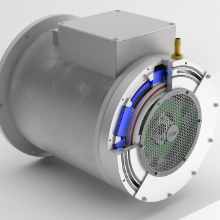Synchronous machines are electric rotating field machines which require a direct magnetic field on the rotor for their operation. This can either be precipitated by permanent magnets or generated by an electrical winding. The permanently magnetically excited synchronous machine is becoming increasingly important in the medium power range (1kW-100kW). However, the disadvantage of this machine is that permanent magnets are sensitive to temperature and difficult to calculate due to the usage of rare earth metals. In addition, the nonadjustable magnetic field of the permanent magnets has a negative effect on the efficiency of the machine, especially at high speeds. Therefore, the industry has an interest in finding a reasonable alternative to permanent magnet synchronous machines.
The electrically excited synchronous machine is one such alternative. However, since energy is required on the rotor side for the electrical coil/winding, this must be transferred from the stator to the rotating rotor. For electrically excited synchronous machines with high power (>100kW), this is done by means of slip rings. In the medium power class (1kW-100kW), which is used, for instance, in electric mobility, hardly any electrically excited synchronous machines are currently employed, since the sliding contacts are undesirable, especially in electric vehicles.
With the use of an inductive energy transfer system, a contactless and thus wear-free alternative to slip rings can be created. The coil system of the inductive cet system can be integrated in the shaft or between the winding heads of the motor to save space. Another advantage is the very high efficiency of the inductive transformer system, which above all limits heat generation.
An inductive electrically excited synchronous machine (iEESM) with an integrated cet system still poses a number of technical challenges, which are currently being researched at IEW using several prototypes. These include, for example, trouble-free estimation of rotor current and rotor winding temperature during operation of the iEESM. Another important research topic is the combined design and optimization of the entire drive system consisting of the electric machine, the inverter and the inductive transmission path. The precise determination of heat generation in the transformer and optimized integration of the coil system into the shaft are also current research topics in the field of iEESM.



